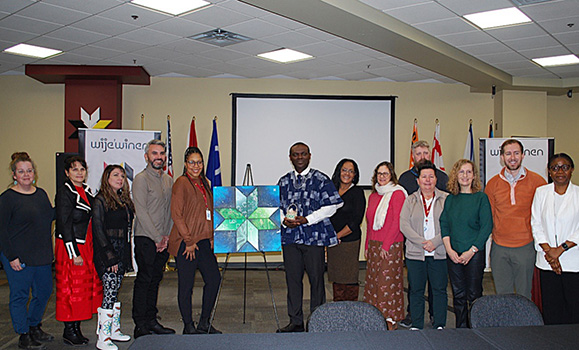The Indigenous community in Halifax will have more access to culturally-safe mental health care thanks to a collaboration between the Mi’kmaw Native Friendship Society – Wije’winen Health Centre and the Department of Psychiatry at HÂţ» University and Nova Scotia Health Central Zone.
The partnership was formalized in early 2025 with the signing of a Memorandum of Agreement (MOA). The MOA outlines dedicated, sustainable psychiatric resources to be provided to the Wije’winen Health Centre. The centre is the first primary care clinic to serve the urban Indigenous population in Kjipuktuk (Halifax).
“Mental health is a fundamental pillar of overall health,” says Dr. Vincent Agyapong, head of Psychiatry for Dal and NS Health Central Zone. “Yet, in many communities, including Indigenous communities, there are significant gaps in access to appropriate, culturally-sensitive mental health services. These gaps have, for far too long, left many individuals and families without the care and support they deserve. This partnership is an exciting step toward bridging that gap.”
Shaping a structural approach
The Indigenous Mental Health Program will include the Wije’winen Health Centre’s principles of etuaptmumk (two-eyed seeing) and netukulimk (interconnectedness).Ěý
“This Memorandum of Agreement represents an important milestone in the relationship between the urban Indigenous community in Halifax, and the Department of Psychiatry,” says Dr. Brent Young, Wije’winen Health Centre’s clinical lead.Ěý
“We know that colonialism fuels mental health inequities among Indigenous people, and structural approaches such as this one are part of a broader approach to dismantling structural anti-Indigenous racism in Canada. Through this agreement, the urban Indigenous community will have access to dedicated psychiatric resources via Wije’winen Health Centre, and we will have the ability to shape a psychiatric care service that is culturally safe and relevant for Indigenous people.”
Psychiatric care delivered at the centre is part of the Department of Psychiatry’s Transcultural Mental Health Program, established to provide accessible, culturally-competent, culturally-safe, and collaborative mental health care for African Nova Scotians, Newcomers, and Indigenous people in Nova Scotia.
“Formal arrangements like the MOA are so important because they signal our willingness to enter into true partnership that honors the sovereignty of Indigenous people and have us working alongside them to improve mental health,” says Dr. Gaynor Watson-Creed, associate dean, serving and engaging society in Dal’s Faculty of Medicine.Ěý
 Ěý
Ěý
Listening and learning
Initial discussion about a MOA began in 2023 following the one-year anniversary of the Wije’winen Health Centre.Ěý
“Since the opening of the Weji’winen in July 2022, I've had the honour of serving as a diplomatic interface between our department and urban Indigenous community,” says Dr. Keri-Leigh Cassidy, a psychiatrist and director of social policy & advocacy for Dal’s Department of Psychiatry. “It's been a privilege to listen and learn from Indigenous people.”
A new academic pillar in the Department of Psychiatry, social policy and advocacy’s mandate involves closing gaps in including, serving and engaging equity-deserving groups. Dr. Cassidy and the Social Policy and Advocacy Committee developed a strategy and five guiding principles, which Indigenous knowledge directly informed, she says.Ěý
The committee’s membership also includes an Indigenous Elder — a first in the history of the Department of Psychiatry.
“Two-eyed seeing” is also one of five guiding principles of the department’s social policy and advocacy strategy. The others relate to the Indigenous concept of netukulimk or interconnectedness. They are: “do no harm,” “nothing about us without us,” “people first with kindness,” and “strength-based.”
Dr. Cassidy views the signing of the MOA as an important first step on the department’s path toward Truth and Reconciliation, and as an ongoing commitment to co-create the program together.
For example, based on feedback from Indigenous people with lived-experience, she says, psychiatrist Dr. Alex Whynot has co-developed the “Two-Eyed Seeing Psychiatric Assessment” to guide non-Indigenous psychiatrists in the Transcultural Mental Health Program to provide culturally-safe psychiatric assessments.Ěý
The work of Dr. Cinera States, the first psychiatrist to offer consultations through the program, has received the praise of the community, says Dr. Cassidy, feedback which she considers to be the most important measure of success.Ěý
A trusted partner
Since becoming department head in 2021, Dr. Agyapong has implemented new mental health services, such as the Transcultural Mental Health Program, designed to close treatment gaps for equity-deserving groups. Addressing health inequalities is a collective responsibility and should be done through innovative programs, he says.
Dr. Cassidy acknowledges adhering to the five guiding principles of the social policy and advocacy strategy is key to the department becoming a more trusted partner with community.Ěý
“By providing psychiatric services to the Wije’winen Health Centre Clinic, we are not just offering clinical expertise — we are opening a door to a culturally-competent, compassionate, and community-centered approach to mental health care,” says Dr. Agyapong.Ěý
“We recognize that mental health does not exist in a vacuum, and we must understand and honour the unique challenges faced by Indigenous individuals, families, and communities when providing care.”

